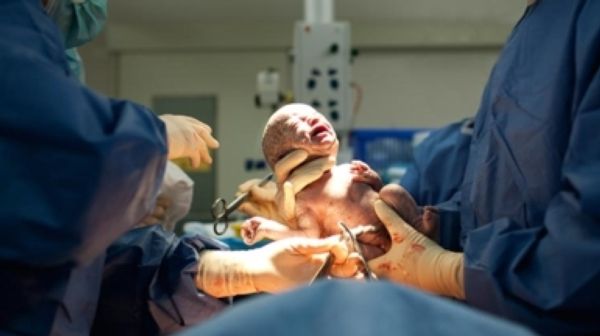New Technique at Birth may Restore Microbiota in Babies Delivered by C-Section
Mindd Foundation

A preliminary study published in the esteemed international medical journal, Nature Medicine, has shown that it is possible to partially restore the microbiota of infants born by C-section 1.
The revolutionary study involved transferring maternal microbes to the baby within 2 minutes of birth. This is the first study of its kind to actively address the issue of microbial alterations after C-section.
The microbiome
The human body is awash with a variety of microbial organisms, including bacteria, viruses, fungi, yeasts and parasites. The collective term for these is the microbiome and they have a vital function to play in human health. They are known to influence digestion, immunity(2) and the synthesis of essential amino acids and vitamins, such as the vitamin K group and vitamins B12 and B3. One of the most widely studied areas of the microbiome on health is that of the gut bacteria. So, why is it important to address the microbiota of C-section babies?
Effect of C-Section on Microbiota
There has been an increase in the incidence of C-section births and in some countries this may exceed over 50% of total births. During vaginal birth, the baby is exposed to maternal microbiota and the baby develops microbial communities similar to that of the maternal vagina. C-section babies demonstrate an altered microbiota and are commonly enriched in the skin and oral microbiota instead3. They may also be colonized with bacteria from the surrounding hospital environment. Many studies show that the difference in microbiomes between vaginally delivered and C-section babies can persist up to 12 months of age.
Effects of an Altered Microbiota
A baby is born “sterile” and relies upon exposure to maternal microbiota in order to become “seeded” with beneficial microbiota. An altered microbiota has been linked to many conditions including obesity, diabetes, autoimmune and other immune disorders, psychiatric issues, and allergies(4-7). The development of eczema(8), an increasingly common childhood complaint has been linked to C-section delivery.
Details of the Study
Eighteen mothers and infants were included in the study, 7 went on to deliver vaginally and 11 were delivered by C-section. Of those delivered by C-section 4 infants were exposed to maternal vaginal fluids within 2 minutes of delivery. The maternal vaginal fluids were transferred to the baby’s mouth, face and the rest of the body via a gauze swab which had been inserted in the vagina for one hour prior to the C-section. It is important to note that the mothers were screened for the absence of HIV, chlamydia and Group B Streptococcus and were clear of signs of vaginosis and viral infections. A vaginal pH of <4.5, 1-2 hours before delivery, was also an important requirement. This is important to prevent passing on detrimental microbes to the infant.
Samples from the infants were taken at 6 different points during the first 30 days of exposure and showed some interesting results:
- Microbial colonization of body sites in the newborn occurs quickly –within the first month
- Exposed infants and those delivered vaginally showed similar microbiomes including an early enrichment of Lactobacillus species – this was not seen in the non-exposed C-section infants
- No adverse effects were observed in the 4 infants who underwent this procedure
- Full microbiome restoration did not take place
The partial restoration of microbiota may be due to several factors including antibiotic use associated with C-section, suboptimal transfer of maternal microbiota to the gauze or to the baby, or the fact that the technique was only applied once.
At this current point in time, this is still an experimental technique and it is not available to babies born by C-section. However, there are still ways to optimize the health of the microbiome.
How to Maximize your Microbiota Prior to Delivery
- Avoid any unnecessary antibiotics during pregnancy, labor or delivery and in the period after delivery
- Have a healthy diet – rich in prebiotics, like oligosaccharides. This provides food for gut microbiota. These can be found in a variety of foods including oats, bananas, onions, garlic, Jerusalem artichokes and chicory
- Fermented foods such as miso, fermented vegetables, and kefir also provide beneficial microbes
- Avoid stress, which is known to negatively influence gut microbiota 9
- Consider a broad-spectrum probiotic supplement. Guidance from a well-trained and experienced practitioner will help you establish the right type
Supporting the Newborn Infant’s Microbiota
- Have skin to skin contact with your baby straight after delivery; this increases the transfer of beneficial microbes
- Avoid bathing the baby for the first 24 hours after birth, some advocate only using water for bathing for the first few months to avoid disrupting the delicate balance on the skin
- Breastfeeding also enhances colonization and as breast-milk is rich in oligosaccharides it also provides prebiotics. It may also be worth considering extending breastfeeding to 12 months of age
- Avoiding excess antibiotic use in infancy can also keep a healthy, balanced microbiota
- Infant probiotics may also be indicated and a skilled practitioner will be able to suggest specific species beneficial to infants.
This preliminary study has opened up the debate on the need for restoring the microbiota in C-section babies. Although further research is required, with larger studies and with regards to safety and modified methods of maternal microbiota transfer, it is clear that the technique has valid application. Although this technique is not currently available in hospitals that undertake C-section deliveries there is certainly hope that one day soon it will become standard. In the meantime, taking steps to keep yourself, and your microbiome, healthy can still play a role in the microbiota balance of your baby.
It is always advisable to work with a certified and experienced Integrative practitioner. Click here for directories worldwide.
References
1. Dominguez-Bello, M. et al. (2016). Partial Restoration of the microbiota of caesarean-born infants via vaginal microbial transfer. Nature Medicine. 22, 250-253.
2. Olszak T, et al. (2012) Microbial exposure during early life has persistent effects on natural killer T cell function. Science. 336:489–493.
3. Cox LM, et al.(2014) Altering the intestinal microbiota during a critical developmental window has lasting metabolic consequences. Cell 158:705–721.
4.Thavagnanam S, Fleming J, Bromley A, Shields MD, Cardwell CR.(20080 A meta-analysis of the association between Caesarean section and childhood asthma. Clinical and experimental allergy : journal of the British Society for Allergy and Clinical Immunology. 38:629–633.
5. Pistiner M, Gold DR, Abdulkerim H, Hoffman E, Celedon JC. (2008) Birth by cesarean section, allergic rhinitis, and allergic sensitization among children with a parental history of atopy. J Allergy Clin Immunol. 122:274–279.
6. Huh SY, et al. (2012) Delivery by caesarean section and risk of obesity in preschool age children: a prospective cohort study. Archives of disease in childhood. 97:610–616.
7. Sevelsted A, Stokholm J, Bonnelykke K, Bisgaard H. (2015) Cesarean section and chronic immune disorders. Pediatrics. 135:e92–e98.
8. Renz-Polster, H., David, M. R., Buist, A. S., Vollmer, W. M., O’Connor, E. A., Frazier, E. A. and Wall, M. A. (2005), Caesarean section delivery and the risk of allergic disorders in childhood. Clinical & Experimental Allergy, 35: 1466–1472.
9. Lyte M, Vulchanova L, Brown DR. (2011) Stress at the intestinal surface: catecholamines and mucosa-bacteria interactions. Cell Tissue Res 343: 23-32.




